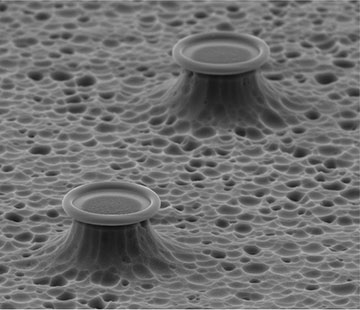
The researchers used microtoroid optical resonators as sensors. Each microtoroid is approximately the width of a human hair. [Image: Adley Gin]
Researchers in the United States have developed an ultra-sensitive, label-free biosensing system that can detect a single macromolecule (Nat. Commun., doi: 10.1038/s41467-024-51320-x). FLOWER, an acronym for “frequency-locked optical whispering evanescent resonator,” leverages whispering-gallery-mode optical microcavity technology to detect membrane–protein binding events in real time.
“FLOWER is a platform technology, which can be used for many real-world applications, including medical diagnostics as well as food-, air- and water-quality monitoring,” said study author Judith Su, University of Arizona. “We have used FLOWER for diagnostics of ovarian cancer and Alzheimer’s disease, as well as environmental monitoring of toxic industrial chemicals and chemical warfare agent surrogates.”
A micro-interferometer
In recent years, whispering-gallery-mode resonators have attracted a significant amount of interest for biosensing applications, due to their high sensitivity and label-free nature. These devices confine light within a cavity through total internal reflection, taking the form of microspheres, microtoroids or microrings. Light waves are continuously reflected, and photons circulate through the resonator many times, resulting in very sensitive measurements at the microscale and nanoscale.
The core sensing element of FLOWER is a silica microtoroid, a geometry known for long photon confinement times that span hundreds of nanoseconds. First, the microtoroid is functionalized with a synthetic phospholipid membrane doped with membrane receptors. Then, a tunable laser (765 to 781 nm) is coupled to the resonator through a tapered optical fiber within a liquid sample. The laser is also frequency-locked to the resonator so that the wavelength matches the microtoroid resonance.
As protein or lipid materials land on the microtoroid surface, the effective refractive index of the optical mode increases, causing a shift in resonance frequency proportional to the number and size of analytes bound. “As analytes of interest enter the evanescent field of the microtoroid, they cause a change in the resonance frequency,” said Su. “FLOWER locks the frequency of the laser to the resonance frequency of the cavity, and as such can track small shifts.”
The core sensing element of FLOWER is a silica microtoroid, a geometry known for long photon confinement times that span hundreds of nanoseconds.
FLOWER’s future
During experiments, FLOWER could successfully detect cholera toxin B, a subunit of the cholera toxin secreted by the bacterium Vibrio cholera, in real time. The device also showed promise for drug-screening applications, demonstrated by its zeptomolar (10-21 M) detection of opioid peptides binding to kappa-opioid receptors, a key component of emotional and behavioral responses to stress and pain.
In addition to pathogen and drug testing, Su hopes to use FLOWER to better understand the fundamental mechanisms of olfaction and taste. She recently received a US National Science Foundation CAREER Award to develop an optical nose that combines FLOWER with an olfactory sensor to detect volatile organic compounds.
“We are working on our next-generation systems, which add additional capabilities to FLOWER such as photothermal microscopy and frequency comb spectroscopy,” Su said. “In addition, we are working to miniaturize FLOWER to make it a portable device.”
